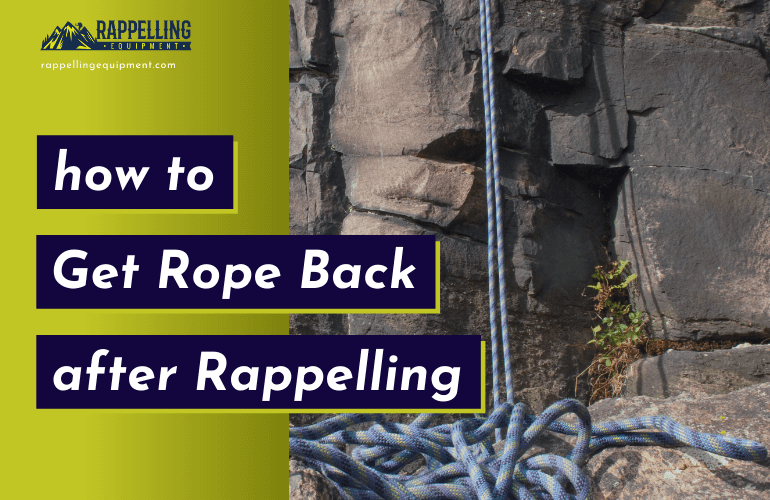If you have ever been rock climbing, then you know the thrill of reaching the top in the exhilaration of rappelling down the side.
But what do you do when you realize that you are at the bottom of the rock and your rope is stuck at the top? A really good rappeling rope is far too expensive just to leave me hanging. Let’s explore how to get rope back after rappelling.
Using One Rope
First, make sure that you have a rope with enough length to reach the ground with both ends. The length of the rope is what makes this work. Tie a double-figure 8 exactly at the bight (loop) of the rope. Next, tug on one end of the rope and thread it through the two rings at the anchor.

You will need extra chains and rappel rings so you can attach them to the anchor’s point. It’s ok to leave them. You may find them useful if you choose to climb this same rock someday. If nothing else, other rappellers will find them invaluable.
Check for safety. Find the knot, then rappel on the opposite side to prevent the rope from slipping through. Check the knot and rope for snags and other issues that may pose a challenge for you on the way down—rappel to the next point or the bottom.
Follow all safety procedures once again. After you reach the bottom, pull on the knotted side of the rope, and it should easily fall down.
Using Two Ropes
Let’s assume that you have just finished a big climb at an impressive rock site. Now, you and a friend are all ready to rappel down. How do you make sure that your ropes get to the bottom safely with you? Well, you should have already tied the two ropes together using the well-known double figure 8 knot.
Next, make sure that you stack your two ropes individually, making sure they do not touch. You can then throw or drop them in separate piles so that they do not get entangled and end up getting stuck on the rock or cliff.
It is almost impossible to do too many safety checks because you want to make sure that the rope and rings are secure and free of snags since they will be supporting your weight and that of your partner. Before you start to repel, you should observe your rappelling rigging and how it is set up.

Check the knot between the two ropes to see if it is adequately secured and tied tightly. Also, make sure that the tails of the rope are secure. Make sure that you understand what is the difference between dynamic and static rope.
Consider the hang of the rope as it goes through the metal ring and ensure that the slings (runners) or chains that hold the ring to the anchor bolts are sturdy and in good shape. You may find, because these pieces of rappelling equipment take a great deal of wear and wait, that you will need additional slings as added support.
Safety Checks
Some other things to consider are whether the ropes are tangled. If your ropes are twisted or knotted together, that can create some major problems. Take great pains to ensure that both pieces of rope down the rock from the anchor without coming in contact with each other.
Also, remember that as you are rappelling, the ropes will want to twine together as well. Many experts at rock climbing and who know how to get rope back after rappelling has found that using a finger as a guide to keeping the ropes separated is the most effective way to make sure that you can retrieve them when you get to the bottom.

A good rule is to make sure that the last person to touch the ground separates the ropes so that when they drop, they do not get kinked up or tangled as they say hit the next anchors.
The easiest way to do this is using a finger of your dominant or god hand on top of the device between the ropes as you are coming down. Using that finger this what makes the ropes stay separate and also saves you time from having two keep stopping to pull them apart physically.
One last thing is to study the rock you plan to climb. Look for any features that can hang up the ropes. This would include sharp edges, grooves, notches, and any plant growth-like branches that can keep the ropes conveniently suspended.
If you follow the suggested guidelines, you can become proficient in how to get the rope back after rappelling.
